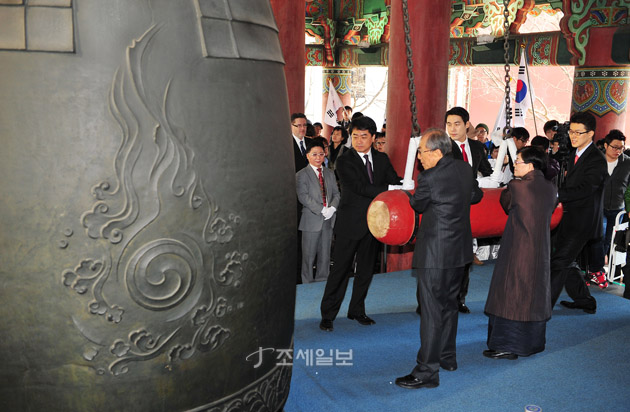SEOUL – Czech Ambassador takes part at March 1 Bosingak bell-ringing ceremony
08.03.2012 / 08:18 | Aktualizováno: 09.03.2018 / 04:18
Ambassador of the Czech Republic Jaroslav Olša, jr. was selected by Seoul Metropolitan Government to take part in bell-ringing ceremony at Bosingak, a ceremonial bell that is Korean No. 2 national treasure, on March 1, 2012. „It was a great honour for me to be one of twelve people to toll Bosingak, such an important historical relic for Korea in the heart of Seoul,“ said Czech Ambassador Jaroslav Olša, jr. This ceremony marks the anniversary of March 1, 1919, when Korean patriots announced the independence of Korea, then under Japanese yoke.
Every year since 1953, when this ceremony was enacted, Mayor of Seoul, Chairman of Seoul City Council and Head of Jongno-gu office, where Bosingak is located, officiate this event with special invited guests - independence activists, distinguished personalities, celebrities, civil representatives and/or senior members of various fields. In three groups of four persons each of them toll the bell 11 times to remember 33 heroic Koreans who, back in 1919, signed the Declaration of Independence.

Ambassador Jaroslav Olša, jr. (in the back) waiting for his turn to toll the Bosingak
Of nine invited guests this year, one, 88-years-old Kim Yung-kwon, was an independence fighter while two others (An Hung-soon and Chung Yo-heon) are descendants of important figures of Korean fight for independence. Other figures included presbyterian pastor Han Kuk-Yom, an activist fighting for a case of comfort women, singer Seo Hee, a well-known supporter of Dokdo case, and popular Jo Hui, an actor who impersonated one of the symbolic figures of Korean fight for independence, An Jung-geun, in recent popular Korean musical „Hero“. The young generation was represented by 18-year old secondary school student Yoon Sin-woo. Ambassador of the Czech Republic Jaroslav Olša, jr. was honoured with the invitation for his donation of books and journals related to March 1 Movement to Seoul Museum of History last year. He is one of only a handful of foreigners who were given such an honour since enactment of bell-ringing ceremonies on March 1 in 1953.

all the invitiees cheering the crowd in front of the Bosingak
Bosingak (보신각 / 普信閣) is a large bell pavillion, a name of which could free be translated as „loudly ringing trust between the king and his people," and it also gave the name to one of the main and the busiest streets of Seoul – Jongno, which literally means "Bell Street". Build and installed in 1396, Bosingak used to be rung twice a day to announce the time and to signal the opening and closing of the Korean capital´s four gates during the Joseon empire until the early 20th century. Today, it is rung only three times a year: on March 1st in celebration of Korea’s Independence Movement, on August 15th to remind of Korea’s Independence, and on New Year’s Eve. The bell-ringing events usually draws crowds of people, the most popular being the one on New Year’s Eve, when the whole area around Bosingak is closed to traffic and becomes packed with people.
March 1, 1919 is one of the most important events in modern Korean history and its spirit continues to live on in modern Republic of Korea, when the streets are filled in with national flags and people enjoy a National holiday.
More about the historical background:from official web page:
„On the first day of March, 1919, the great movement to take back the nations lost sovereignty took place all across the country. At the time Korea was under the iron-fisted rule of Imperial Japan, forcibly annexed nine years earlier. Korean leaders decided on a peaceful demonstration when U.S. President Woodrow Wilson declared the principle of “self determination” for all peoples. Koreans, taking the words at face value, began months-long preparation for a big demonstration to show to the world how Korea desired to be liberated from Japan. Across the nation secret messages and Korean national flags (Taegukgi) were distributed and there was even a delegation dispatched abroad to make proper representation of Korea.
On the big day people rushed to the streets to hail the national independence of Korea as they waved flags and marched. What couldve been a peaceful demonstration soon turned into a massacre as the Japanese authorities, caught completely off guard, resorted to extreme measures by either shooting down or beating people to death. The 33 national leaders who were supposed to lead the crowd that day were already put behind bars. Of the 2 million participants in the peace demonstrations, over 7,500 died, nearly 16,000 lay injured and over 52,000 were arrested. A total of 715 civilian houses, 47 churches and two schools were burnt down.
Although the demonstration itself was a failure that ended with a terrible cost, the spirit demonstrated during the movement continues to stand as a bright icon of national independence. It also contributed to the establishment of the Korean Provisional Government in Shanghai in the same year, among other things. In October 1949, four years after national liberation, March 1st was officially designated one of the four major national holidays.“
Link to Ambassador´s article on Czech relation to March 1 Movement and Korean independence fight in the late 1910s and early 1920s.
http://www.mzv.cz/public/67/9f/9d/473022_358724_march1_movement.pdf



